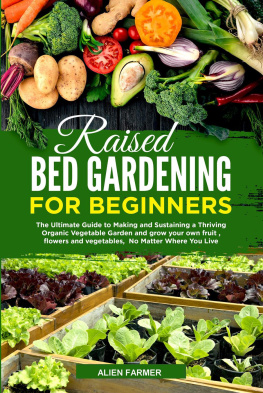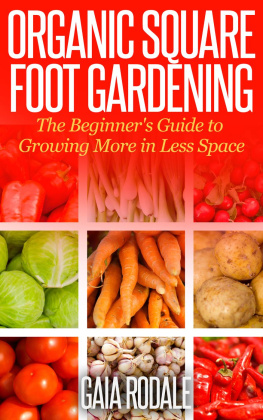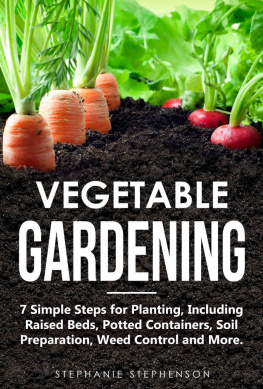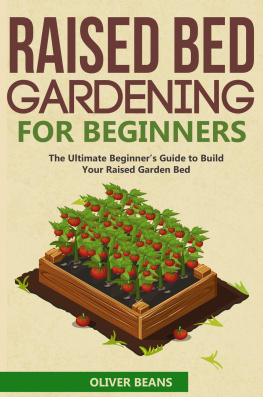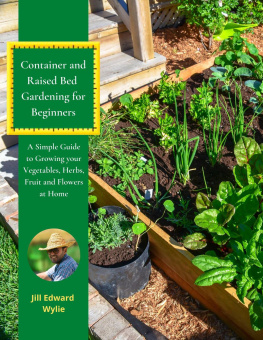Ailen Farmer - Raised Bed Gardening for Beginners: The Ultimate Guide to Making and Sustaining a Thriving Organic Vegetable Garden and grow your own fruit , flowers and vegetables, No Matter Where You Live
Here you can read online Ailen Farmer - Raised Bed Gardening for Beginners: The Ultimate Guide to Making and Sustaining a Thriving Organic Vegetable Garden and grow your own fruit , flowers and vegetables, No Matter Where You Live full text of the book (entire story) in english for free. Download pdf and epub, get meaning, cover and reviews about this ebook. year: 2020, publisher: Said Echa, genre: Children. Description of the work, (preface) as well as reviews are available. Best literature library LitArk.com created for fans of good reading and offers a wide selection of genres:
Romance novel
Science fiction
Adventure
Detective
Science
History
Home and family
Prose
Art
Politics
Computer
Non-fiction
Religion
Business
Children
Humor
Choose a favorite category and find really read worthwhile books. Enjoy immersion in the world of imagination, feel the emotions of the characters or learn something new for yourself, make an fascinating discovery.
- Book:Raised Bed Gardening for Beginners: The Ultimate Guide to Making and Sustaining a Thriving Organic Vegetable Garden and grow your own fruit , flowers and vegetables, No Matter Where You Live
- Author:
- Publisher:Said Echa
- Genre:
- Year:2020
- Rating:3 / 5
- Favourites:Add to favourites
- Your mark:
Raised Bed Gardening for Beginners: The Ultimate Guide to Making and Sustaining a Thriving Organic Vegetable Garden and grow your own fruit , flowers and vegetables, No Matter Where You Live: summary, description and annotation
We offer to read an annotation, description, summary or preface (depends on what the author of the book "Raised Bed Gardening for Beginners: The Ultimate Guide to Making and Sustaining a Thriving Organic Vegetable Garden and grow your own fruit , flowers and vegetables, No Matter Where You Live" wrote himself). If you haven't found the necessary information about the book — write in the comments, we will try to find it.
Its time to build your own RAISED BED GARDEN!
Even if you dont have a lot of time for gardening, you can still have a productive vegetable garden, no matter the size. How? KEEP READING! Start with a raised bed. Its the shortcut to a plentiful harvest, even in the first year. Heres why:
Build YOUR Garden anywhere. Attractive cedar raised beds are an asset to your landscape. Create perimeter gardens, spice up your entryway, grow food in your front yard, screen an eyesore.
GROW more food in less space. You can set plants closer together so every square inch is productive. And small-space gardening techniques, such as succession planting and vertical supports, ensure that every square inch of space is used.
PLANT earlier. Excess water drains better and soil warms up faster in spring compared to in-ground beds. Specialized covers and garden fabric help you get started even earlier.
BETTER soil. A productive vegetable garden depends on good soil. With a raised bed, you start fresh with the ideal soil blend even if the soil on your site is poor.
Included in this book...
Although there are many books available at the moment on Raised Bed Gardens this book is different because it really takes you into the details, from building your own raised bed garden to making your own fertilizer and which are the best and most attractive crops you should be growing.
Are you a keen gardener, keen to take your hobby or professional interest to the next level?
If the answer is YES...
Buy NOW and download YOUR Copy TODAY!
Ailen Farmer: author's other books
Who wrote Raised Bed Gardening for Beginners: The Ultimate Guide to Making and Sustaining a Thriving Organic Vegetable Garden and grow your own fruit , flowers and vegetables, No Matter Where You Live? Find out the surname, the name of the author of the book and a list of all author's works by series.

